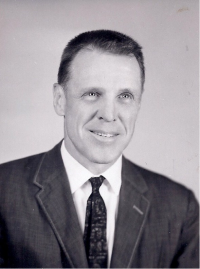 |
 |
Myron H. Nichols (SM'55) was born in Nelson, Ohio, on January 26, 1915. He graduated from Oberlin College in 1936 and received the Ph.D. degree in physics in 1939, from Massachusetts Institute of Technology, Cambridge, where he held Teaching Fellowships and the Coffin and Saltonstall Fellowships.
From 1939 to 1941 he was a National Research Fellow in physics at Princeton University, Princeton, N.J., working in the field of thermionic emission. In 1941-1942 he was involved in the precursor of the Manhattan Project.
In 1943 the need for radio telemetry systems for testing structural dynamics of high performance aircraft became urgent. On June 1, 1943, Division 17 of the National Defense Research Committee of the Office of Scientific Research and Development initiated a contract for work at Princeton University to produce a 20-channel high-speed time-division telemeter with Dr. Nichols as supervisor. The first model was used for successful flight tests on the YP-59 jet fighter in October 1944.
In 1944 the Princeton group was enlarged to assist the Applied Physics Laboratory of Johns Hopkins University with instrumenting and flight testing a series of experimental supersonic ramjet vehicles as part of the Navy Bureau of Ordnance Bumblebee Program. FM/FM telemetry was developed and constructed to meet the requirement for subminiature telemetry and sensing instruments. Flight tests were made at a test site on the New Jersey seashore.
In July 1945 the Princeton Telemetry Group undertook the instrumentation and telemetering for the early test flights of the subsonic Lark missile under contract with the Navy Bureau of Aeronautics. A PAM/FM/FM telemeter was developed and constructed for this purpose, and flight tests were conducted at the Inoykern site (now NAVAIR China Lake).
Members of the Princeton Group organized the first comprehensive telemetry conference, held at Princeton University on February 19 and 20, 1946. The proceedings' are an interesting account of early telemetering work. Of the 37 papers presented, three summarized telemetering work in England. Examples of nearly all possible systems of modulation and multiplexing were reported.
During the early years it was necessary to design and fabricate nearly all of the airborne and ground equipment “in-house.” About the only component commercially available was the radio receiver, which it was frequently necessary to modify. Thus each project amounted to a comprehensive effort to which many people contributed, including: H. Ashworth, J.G. Barry, J.F. Brinster, R.B. Blizard, D.B. Davis, T.K. Collins, W.C. Johnson, B. Kurrelmeyer, J. Larson, L.L. Rauch, W.B. Roberts, E.J. Schaefer, W.D. Stevenson, and A.G. Wentzel.
In the summer of 1946 Nichols joined the Aeronautical Engineering Department of the University of Michigan as Associate Professor. In addition to teaching, he headed several projects involving the application of rockets to high-altitude meteorological measurements. He was a member of the Upper Atmosphere Research Panel, also known as the V-2 Panel, which was formed to oversee experiments conducted using V-2 rockets brought to the United States after World War II. The experiments studied the upper atmosphere, solar radiation and X-ray astronomy, as well as the technology of the V-2 rocket. This work, from 1946 to 1960, involved the instrumentation of large and small rockets, including telemetry and sensing instruments. One of the principal results was measurement of temperature and composition of the upper atmosphere.
From 1949 to 1951 he was Associate Professor at California Institute of Technology. During this period he chaired one of the Research and Development Board working groups on missile flight testing.
From 1954 to 1957 he was a member of the Senior Technical Staff at The Ramo Wooldridge Corporation, where he was involved in the development and testing of the Atlas missile.
In 1960 Dr. Nichols became a full-time consultant, operating out of La Jolla, Calif., mostly in the telemetry and data handling fields. He has published numerous papers on telemetry and its application and co-authored the book Radio Telemetry with L.L. Rauch. He was active in establishing interrange instrumentation group (IRIG, now called the Range Commanders Council) Standards on range telemetry (IRIG-106) and in both the National and International Telemetry Conferences (NTC, ITC).
Dr. Nichols organized several lecture series on information and decision theory and electronic data processing for the San Diego Section of the IEEE. Among the awards he received for work in the telemetry field are the Naval Ordnance Development Award, OSRD Certificate, IRE Professional Group on Telemetry and Remote Control Award, and the National Telemetry Conference “Man of the Year”.
In 1972 the Awards Committee of the IEEE Group on Aerospace and Electronic Systems named Myron H. Nichols as the recipient of its annual Pioneer Award for 1972.The award is in recognition of the contributions of Dr. Nichols to telemetry systems; in particular, those contributions to high-speed electronic time-division multiplex radio telemetering and early FM/FM telemetry for rockets.
Dr. Myron (Nick) Nichols, IEEE Life Fellow, died on 14 May 1999 and is survived by his wife, three children and one grandchild. He will always be remembered as a RF telemetry pioneer to whom we owe a great deal.
This article was based in much part on a article originally prepared by Lawrence L. Rauch while he was Professor and Chairman, Program in Computer, Information and Control Engineering, College of Engineering, University of Michigan. It written as part of the IEEE Pioneer Award and was published in the July, 1972 IEEE Transactions on Aerospace and Electronic Systems. It was furnish courtesy of the Institute of Electronics and Electrical Engineers.
